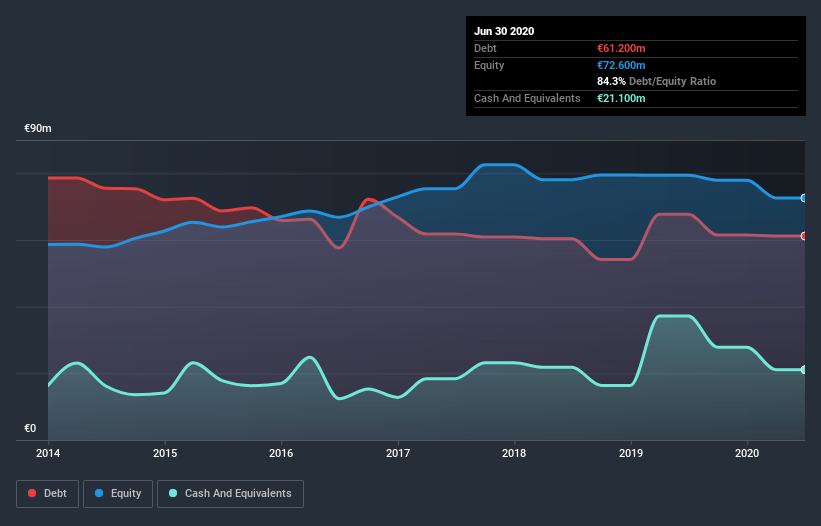Here's Why Keskisuomalainen Oyj (HEL:KSLAV) Has A Meaningful Debt Burden

David Iben put it well when he said, 'Volatility is not a risk we care about. What we care about is avoiding the permanent loss of capital.' When we think about how risky a company is, we always like to look at its use of debt, since debt overload can lead to ruin. As with many other companies Keskisuomalainen Oyj (HEL:KSLAV) makes use of debt. But the more important question is: how much risk is that debt creating?
When Is Debt Dangerous?
Debt and other liabilities become risky for a business when it cannot easily fulfill those obligations, either with free cash flow or by raising capital at an attractive price. If things get really bad, the lenders can take control of the business. However, a more usual (but still expensive) situation is where a company must dilute shareholders at a cheap share price simply to get debt under control. Of course, debt can be an important tool in businesses, particularly capital heavy businesses. When we think about a company's use of debt, we first look at cash and debt together.
View our latest analysis for Keskisuomalainen Oyj
What Is Keskisuomalainen Oyj's Net Debt?
As you can see below, Keskisuomalainen Oyj had €61.2m of debt at June 2020, down from €67.7m a year prior. However, it does have €21.1m in cash offsetting this, leading to net debt of about €40.1m.

How Strong Is Keskisuomalainen Oyj's Balance Sheet?
According to the last reported balance sheet, Keskisuomalainen Oyj had liabilities of €60.6m due within 12 months, and liabilities of €71.1m due beyond 12 months. Offsetting these obligations, it had cash of €21.1m as well as receivables valued at €19.2m due within 12 months. So its liabilities outweigh the sum of its cash and (near-term) receivables by €91.4m.
This deficit is considerable relative to its market capitalization of €102.4m, so it does suggest shareholders should keep an eye on Keskisuomalainen Oyj's use of debt. Should its lenders demand that it shore up the balance sheet, shareholders would likely face severe dilution.
We measure a company's debt load relative to its earnings power by looking at its net debt divided by its earnings before interest, tax, depreciation, and amortization (EBITDA) and by calculating how easily its earnings before interest and tax (EBIT) cover its interest expense (interest cover). Thus we consider debt relative to earnings both with and without depreciation and amortization expenses.
Keskisuomalainen Oyj's net debt to EBITDA ratio of about 1.6 suggests only moderate use of debt. And its strong interest cover of 1k times, makes us even more comfortable. The modesty of its debt load may become crucial for Keskisuomalainen Oyj if management cannot prevent a repeat of the 48% cut to EBIT over the last year. When it comes to paying off debt, falling earnings are no more useful than sugary sodas are for your health. When analysing debt levels, the balance sheet is the obvious place to start. But you can't view debt in total isolation; since Keskisuomalainen Oyj will need earnings to service that debt. So if you're keen to discover more about its earnings, it might be worth checking out this graph of its long term earnings trend.
Finally, while the tax-man may adore accounting profits, lenders only accept cold hard cash. So it's worth checking how much of that EBIT is backed by free cash flow. Over the last three years, Keskisuomalainen Oyj actually produced more free cash flow than EBIT. That sort of strong cash conversion gets us as excited as the crowd when the beat drops at a Daft Punk concert.
Our View
While Keskisuomalainen Oyj's EBIT growth rate has us nervous. To wit both its interest cover and conversion of EBIT to free cash flow were encouraging signs. Looking at all the angles mentioned above, it does seem to us that Keskisuomalainen Oyj is a somewhat risky investment as a result of its debt. That's not necessarily a bad thing, since leverage can boost returns on equity, but it is something to be aware of. The balance sheet is clearly the area to focus on when you are analysing debt. But ultimately, every company can contain risks that exist outside of the balance sheet. To that end, you should be aware of the 2 warning signs we've spotted with Keskisuomalainen Oyj .
At the end of the day, it's often better to focus on companies that are free from net debt. You can access our special list of such companies (all with a track record of profit growth). It's free.
If you decide to trade Keskisuomalainen Oyj, use the lowest-cost* platform that is rated #1 Overall by Barron’s, Interactive Brokers. Trade stocks, options, futures, forex, bonds and funds on 135 markets, all from a single integrated account. Promoted
Valuation is complex, but we're here to simplify it.
Discover if Keskisuomalainen Oyj might be undervalued or overvalued with our detailed analysis, featuring fair value estimates, potential risks, dividends, insider trades, and its financial condition.
Access Free AnalysisThis article by Simply Wall St is general in nature. It does not constitute a recommendation to buy or sell any stock, and does not take account of your objectives, or your financial situation. We aim to bring you long-term focused analysis driven by fundamental data. Note that our analysis may not factor in the latest price-sensitive company announcements or qualitative material. Simply Wall St has no position in any stocks mentioned.
*Interactive Brokers Rated Lowest Cost Broker by StockBrokers.com Annual Online Review 2020
Have feedback on this article? Concerned about the content? Get in touch with us directly. Alternatively, email editorial-team@simplywallst.com.
About HLSE:KSL
Keskisuomalainen Oyj
Engages in publishing, printing, and distributing newspapers and magazines in Finland.
Undervalued with moderate growth potential.
Market Insights
Community Narratives



